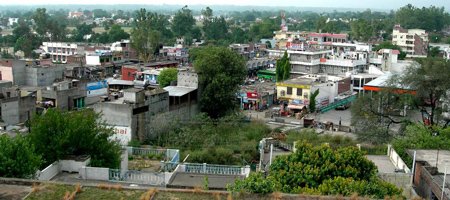The present Una district until 1st Nov., 1966 was one of the tehsil of the Hoshiarpur district of Punjab. Consequent upon reorganization of Punjab all the hill areas including Una tehsil was transferred to Himachal Pradesh. Eversince, until September, 1972 it continued to remain as tehsil of the then Kangra district. On the 1st September,1972 the Himachal Pradesh Govt. reorganised the then Kangra district into three districts namely Una, Hamirpur and Kangra. Una district consists of two Sub-Divisions(Una and Amb), three Tehsils(Bangana, Amb and Una) and two Sub-Tehsils(Haroli and Bharwain) and is having five Development Blocks(Una, Bangana, Gagret, Amb and Haroli). It is believed that the present Una district, minus its Eastern side, was formally a part of the erstwhile Kangra State. Click To EnlargeBulk of the present Una district which is otherwise popularly known as Jaswan Dun was ruled by the Katoch family of Kangra. The Jaswan State which occupied a fertile tract in the JASWAN DUN valley of the outer hills of the historical Kangra state was founded by a cadet of the Katoch line about A.D.1170, whose name is said to have been PURAB CHAND. Jaswan was the first off shoot from the parent stem. It is not improbable, however, that the State was originally a fief (Jagir) which became independent in the unsettled times following on the Muhammadan invasions. From Purab Chand to Ummed Singh 27 Rajas in all ruled the Jaswan State. Not much is known about the JASWAN STATE until the time of AKBAR when it became subject to Mughal rule.
Nangal

The Bhakra-Nangal multipurpose dams were among the earliest river valley development schemes undertaken by India after independence though the project had been conceived long before India became a free nation. Preliminary works commenced in 1946. Construction of the dam started in 1948, Jawahar Lal Nehru poured the first bucket of concrete into the foundations of Bhakra on 17 November 1955 [2] and the dam was completed by the end of 1963. Successive stages were completed by the early 1970s.
Electricity generation
Bhakra and Nangal dams house hydroelectric power generators, which are situated on both the sides of the dams. Nangal hydel Channel and Anandpur Sahib Channel are used for power generation and irrigation purposes. Each power plant consists of five turbines. Two power houses with a total capacity of 1325 MW flank the dam, on either side of the river. The left power house contains 5 x 108 MW Francis turbines while the right 5 x 157 MW.[3] The power generated at Bhakra Power houses is distributed among partner states of Punjab, Haryana, Rajasthan and Himachal Pradesh and also supplied to common pool consumers like National Fertilizers Ltd. and Chandigarh.



